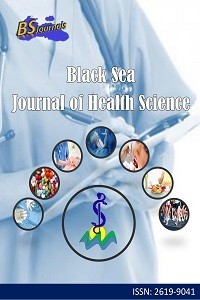İNSAN ISIRIĞI SONRASI NEKROTİZAN FASİİT: OLGU SUNUMU
İnsan ısırığı, Nekrotizan fasiit, Staphylococcus aureus
Necrotizing Fasciitis Resulting from Human Bite: A Case Report
Human bite, Necrotizing fasciitis, Staphylococcus aureus,
___
- Aziz H, Rhee P, Pandit V, Tang A, Gries L, Joseph B. 2015. The current concepts in management of animal (dog, cat, snake, scorpion) and human bite wounds. J Trauma Acute Care Surg,78(3): 641-648.
- Doğanay M, Demiraslan H. 2017. Deri ve Deri Altı Dokusunun Bakteriyel İnfeksiyonları. In: Willke Topçu A, Söyletir G, Doğanay M, eds. İnfeksiyon Hastalıkları ve Mikrobiyolojisi. 4. Baskı. İstanbul: Nobel Tıp Kitabevleri; p. 1162-1167.
- Goldstein EJC. 2010. Bites. In: Mandell GL, Bennett JE, Dolin R eds. Mandell, Douglas, and Bennett’s Principles and practice of Infectious Diseases. 7th ed. Philadelphia: Churchill Livingstone:p. 3911-3915.
- Griego RD, Rosen T, Orengo IF, Wolf JE. 1995. Dog, cat, and human bites: A review. J Am Acad Dermatol, 33: 1019–1029.
- Hosek WT, Laeger TC. 2009. Early diagnosis of necrotizing fasciitis with soft tissue ultrasound. Acad Emerg Med, 16:1033.
- Patil PD, Panchabhai TS, Galwankar SC. 2009. Managing human bites.J Emerg Trauma Shock, 2(3): 186-190.
- Pasternack MS, Swartz Mn. 2010. Cellulitis, Necrotizing Fasciitis and Subcutaneous Tissue Infections. In: Mandell GL, Bennett JE, Dolin R, eds. Mandell, Douglas, and Bennett’s Principles and practice of Infectious Diseases 7th ed. Philadelphia: Churchill Livingstone; p. 1289-1310.
- Pretty IA. 2008. Forensic dentistry: 2. Bite Marks and bite injuries. Dent Update, 35: 48-61.
- Sikora CA, Spielman J, MacDonald K, Tyrrell GJ, Embil JM. 2005. Necrotizing fasciitis resulting from human bites: A report of two cases of disease caused by group A streptococcus. Can Jof İnfect Dis Med Microbiol, 16(4): 221-224.
- Uluğ M. 2012. Necrotizing fasciitis resulting from human bite: A case report of disease caused by Sphingomonas paucimobilis. Flora Derg,17: 187-191.
- Wong CH, Khin LW, Heng KS, Tan KC, Low CO. 2004. The LRINEC (Laboratory Risk Indicator for Necrotizing Fasciitis) score: A tool for distinguishing necrotizing fasciitis from other soft tissue infections. Crit Care Med, 1535-1541.
- Yayın Aralığı: Yılda 4 Sayı
- Başlangıç: 2018
- Yayıncı: Cem TIRINK
TÜRKİYE’DE SAĞLIK SEKTÖRÜNDE VERİ MADENCİLİĞİ KULLANIM ALANLARI
İNSAN ISIRIĞI SONRASI NEKROTİZAN FASİİT: OLGU SUNUMU
Sevil ALKAN ÇEVİKER, Özgür GÜNAL, Süleyman Sırrı KILIÇ
ORTODONTİ ALANINDA KLORHEKSİDİN KULLANIMI: DERLEME
GENİŞ OROANTRAL FİSTÜLÜN DÖRT KATMANLI DOKUYLA KAPATILMASI: VAKA RAPORU
Elshan MURADOV, Mehmet Barış ŞİMŞEK, Mert GÜNDOĞDU
Sapana RANABHAT, Taniya THAPA, Alisha JOSHİ, Shakuntala CHAPAGAİN, Srijana SHRESTHA
